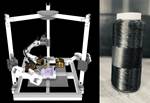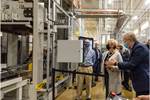Orbital Composites wins AFWERX award for Starfighter drone fleet
Under the TACFI contract, Orbital is implementing the AMCM process to build 3D printed composite multi-mission UAS aircraft, surpassing $10 million in government awards.
Aerospace manufacturing company Orbital Composites (Campbell, Calif., U.S.) has been awarded an AFWERX (Washington, D.C., U.S.) Tactical Funding Increase (TACFI) contract to develop and scale production of its modular unmanned aircraft system, Starfighter X.
Orbital says its patented additive manufacturing compression molding (AMCM) process, which combines robotic, extrusion-based 3D printing with compression molding for low-porosity composite parts, is being leveraged for the Starfighter X. The system enables rapid production of complex aerospace components, a key advantage for this high-performance UAS platform.
The TACFI program aims to accelerate the development and deployment of innovative technologies that address critical national security needs. The contract builds upon Orbital Composites’ recent successes, shifting the company’s total government contract awards beyond $10 million.
Key aspects of the Starfighter X platform include:
- Automation: Orbital Composites has developed robotic, autonomous manufacturing processes for mass production of Starfighter X systems, to significantly reduce costs and lead times.
- Modularity: Starfighter’s modular platform will enable rapid configuration of various drone types from a common set of subsystems.
- Speed: Two variants of Starfighter are in development — one capable of speeds up to 200 miles per hour (mph), and another pushing boundaries beyond 300 mph.
- Versatility: The initial focus is on developing systems for counter-unmanned aerial systems (C-UAS) and cargo resupply missions, with the potential for expansion into other critical use cases.
- Multi-mission capability: Orbital Composites’ process enables the production of Group 1, 2 and 3 unmanned aerial systems (UAS), covering a wide range of capabilities from small reconnaissance drones to larger tactical systems.
Orbital AMCM: A hybrid manufacturing platform with automotive cost and cycle time, while maintaining aerospace quality and performance.
“I started Orbital to build the fastest helicopter ever built,” says Cole Nielsen, founder and CTO of Orbital Composites. “We took a detour to build the necessary machines to build the factory. Now we are ready to start building disruptive products, starting with the Starfighter drones."
“Our contrarian approach of ‘building the factory first’ positions us to tackle the challenges of scaled production,” adds Amolak Badesha, co-founder and CEO of Orbital Composites. “While others focus on prototypes, we’ve invested in creating a factory that can go from concept to mass production in record time. This is now paying off as the DOD [Department of Defense] seeks rapid, scalable solutions.”
Orbital Composites can directly 3D print and fly Starfighter aircraft, while also having the capability to scale to tens of thousands of airframes using the AMCM process. This strategy aligns closely with the Pentagon’s Replicator initiative, which aims to field thousands of autonomous systems for the U.S. warfighter in the next 12-18 months.
The scalability of the company’s robotic autonomous manufacturing processes enables it to potentially support both Replicator and the Collaborative Combat Aircraft (CCA) program. While Orbital Composites intends to develop its own airframes, the company is also in discussion with several prime contractors to accelerate production of larger, more exquisite aerospace platforms.
Related Content
-
PEEK vs. PEKK vs. PAEK and continuous compression molding
Suppliers of thermoplastics and carbon fiber chime in regarding PEEK vs. PEKK, and now PAEK, as well as in-situ consolidation — the supply chain for thermoplastic tape composites continues to evolve.
-
Jeep all-composite roof receivers achieve steel performance at low mass
Ultrashort carbon fiber/PPA replaces steel on rooftop brackets to hold Jeep soft tops, hardtops.
-
Plant tour: Joby Aviation, Marina, Calif., U.S.
As the advanced air mobility market begins to take shape, market leader Joby Aviation works to industrialize composites manufacturing for its first-generation, composites-intensive, all-electric air taxi.

















